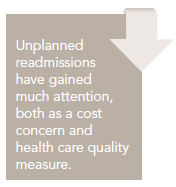Variation in Surgical Readmission Rates and Quality of Hospital Care
Unplanned readmissions have gained much attention, both as a cost and healthcare quality issue.

Srikanth Seethala, MD, MPH
Review
Tsai TC, Joynt KE, Orav EJ, Gawande AA, Jha AK. Variation in surgical-readmission rates and quality of hospital care. N Engl J Med. 2013;369:1134-1142.

Readmission is defined as an unplanned admission to the same or another acute care hospital within 30 days of discharge. Public reporting of readmission rates for some medical diagnoses is mandatory. Recently, total knee replacement and hip arthroplasty were added to the readmission program, while some other surgical procedures are under consideration.1 Authors of this study tried to identify the correlation between hospital performance measures (mortality rate, surgical volume, and Hospital Quality Alliance [HQA] scores) and readmission rate.2 They also attempted to identify hospital characteristics and patient characteristics that are at higher risk for higher readmission rate.
Study Details
Tsai et al collected data on hospitals that provided at least 1 of the following 6 surgical procedures: coronary-artery bypass grafting (CABG), pulmonary lobectomy, endovascular repair of abdominal aortic aneurysm, open repair of abdominal aortic aneurysm, colectomy, and hip replacement. They used 2009 Medicare inpatient data, and 2010 Medicare Provider Analysis and Review (MEDPAR) data to identify the hospitals that provided 1 of the above-mentioned surgical services. The investigators acquired hospital characteristics from the American Hospital Association annual survey, and performance measures from the HQA surgical scores. Patients undergoing CABG concurrently with valve replacement were excluded. They also limited lobectomy for lung cancer, endovascular and open abdominal aortic aneurysm repairs for non-ruptured aneurysms, and colectomy for colorectal cancers. International Clissification of Diseases, Ninth Revision (ICD-9) codes were used to identify the diagnosis. The study also excluded procedures that were performed in December 2009, as readmissions aren’t reported until the following year.
Hospitals were categorized by occupancy [small (<100 beds), medium (100-399 beds), and large (>400 beds)], teaching and non-teaching status, and population served (serving low income vs high income, based on zip codes and US demographic data). Composite mortality rate across 6 procedures were calculated by using indirect standardization of risk-adjusted, procedure-specific 30-day surgical mortality rate. The Elixhauser risk-adjustment approach was used to calculate procedure-specific 30-day readmission rate, and indirect standardization was used to calculate the composite readmission rate for each hospital.
Of 4650 acute care hospitals that provided services to Medicare patients, 3004 hospitals performed 1 of the 6 above-mentioned surgeries. Readmission rates varied between 10.5% and 17.4% for a total of 479,471 surgical discharges. The median risk-adjusted readmission rate at 30 days was 13.1%. Among all the patient characteristics analyzed, only higher age was associated with higher readmission rate. Hospital characteristics that were associated with higher readmission rates are hospitals’ teaching status (13.9% major teaching vs 12.9% nonteaching) (P <.001), for-profit institutions (13.7%) versus nonprofit (13.1% ) (P <.001), and also hospitals serving a higher proportion of Medicaid patients (14.0% vs 13.1%, P <.001). Hospitals from the western part of the country (24.1% vs 14.8%, P <.001) and those with more full-time nurses (median, 7.2 vs 6.9; P <.001) had lower readmission rates. All 3 surgical quality measures—high surgical volumes (12.7% vs 16.8%, P <.001), lower 30-day surgical mortality rate (13.3% vs 14.2%, P <.001), and high HQA Surgical Care scores (13.1% vs 13.6%, P = .02)—were correlated with lower readmission rate on univariate analysis. On a multivariate analysis, HQA score failed to reveal a statistically significant result, but showed a trend toward lower composite readmission rate. Even on multivariate analysis, lower surgical mortality (13% vs 13.8%) and higher procedure volume (12.8% vs 16.5%) have shown a statistically significant association. On individual surgical procedures, these quality measures have not displayed a statistically consistent association.
CommentaryIdentify Modifiable Process Measures and Change Clinical Practices
In recent years unplanned readmissions have gained much attention, both as a cost concern and health care quality measure. Readmissions are making an impact not only on medical costs but also on patient well-being.3 Hospitals are required to report the standardized readmission rate for myocardial infarction, heart failure, pneumonia, total hip arthroplasty, and knee replacement, and this information is now available to the public on the Centers for Medicare & Medicaid Services (CMS) Website. The CMS is considering the addition of more surgical procedures, such as CABG. Since implementation of the new rules, the readmission rate has decreased by more than 0.5%, which translates into approximately 70,000 prevented readmissions compared with previous years.4 The drop in the readmission rate is multifactorial, and one of the explanations is the Medicare penalty program. Beginning in 2015, CMS is decreasing its reimbursements to hospitals up to 3% if they have a readmission rate higher than the national median.1 While social support system and the transition of care between inpatient and outpatient care are some of the key reasons for medical readmissions, postsurgical complications are major contributors to the surgical readmission rate.2,5-7
It is debated in the surgical community whether or not readmission rates are a good predictor of surgical quality.8 Some surgical complications cannot be prevented but can be addressed as an outpatient if identified earlier. Some institutions are implementing process measures to decrease readmission rates.9 This study has confirmed the variations in the surgical readmission rates that previous studies showed. Readmission rates at teaching institutions are high even though process measures are maintained at higher standards. Hospital Consumer Assessment of Healthcare Providers and Systems (HCAHPS) scores are also low in teaching institutions.10 Teaching institutions might need to redesign processes in order to better serve the patients and decrease the readmission rate.10 As in medical readmission, surgical readmission rate is also high in institutions serving patients from low socioeconomic groups.6
Patient education has a significant impact on the readmission rate, which is supported by the fact that hospitals with higher fulltime nursing staff have a lower readmission rate.11 We can divide the risk factors for readmission at the hospital level into modifiable and non-modifiable factors. Modifiable hospital characteristics are better process implementation, higher number of full-time nursing staff, patient education, and post discharge care. Nonmodifiable factors are teaching status, location, for-profit status, and the population group served. Surprisingly, there is no difference in readmission rate between urban and rural hospitals. The American College of Surgeons’ National Surgical Quality Improvement Program (ACS NSQIP) is a well-validated index for 30-day readmission rate. This program presents not only cumulative surgical readmission rates but also presents individual surgical readmission rates, and differentiates between planned and unplanned readmissions, and readmissions that are unrelated to the index procedure. It is well correlated with the Medicare administrative readmission rate, which provides a cumulative readmission rate. As ACS NSQIP data continue to provide both individual and cumulative information, hospitals will be informed about specific reasons for readmissions and how they can be addressed.3,7
Readmission rates for CABG did not correlate with mortality rates in a study of the procedure in a single state.12 Tasi et al have shown that lower mortality rate was well correlated with lower readmission rate nationally.2 Pre-screening and a good systematic approach might have played a role in this correlation, but further research is needed to identify other factors that are contributing to this phenomenon. Higher volume of procedures is associated with lower readmission risk. Along with a good systematic approach before surgery, early identification of the complications by instituting process measures (eg, discharge clinics) might have resulted in this trend. Performing elective procedures only at highly experienced centers might provide a better outcome, but the practicality of this approach should be carefully investigated, as low-volume centers might need to perform emergency procedures. There are some exceptions: some small institutions have recorded lower readmission rates than the national median. Further research is needed to identify factors behind their low readmission rates.
As more and more literature accumulates on risk factors for readmission on individual procedures like carotid endarterectomy, GI surgeries, plastic surgery, and CABG, hospitals need to identify the modifiable process measures and change clinical practices according to their need.5,12 Further research is needed regarding the implications of performing elective procedures only at high-volume institutions, including evaluating HQA score correlations with readmission rates, readmission rate as a true measure of surgical quality, and performance measures as a surgical quality measure in younger patient populations. Along with administrative data, ACS NSQIP will provide additional information about both preventable and unpreventable readmissions. With more information, hospitals will be able to identify risk factors for readmissions not only for specific surgical procedures but also at the facility level. Hospitals will be able to design and redesign their processes to address specific needs.
It is important to note that this study had some limitations worthy of mention. It included only Medicare patients, and defined readmission rate as 30 days from discharge. Finally, administrative data might not have identified precise risk adjustments.
References
1. Readmission reduction has begun and the penalties will escalate. Hosp Case Manag. 2013;21:45-47.
2. Tsai TC, Joynt KE, Orav EJ, Gawande AA, Jha AK. Variation in surgical- readmission rates and quality of hospital care. N Engl J Med. 2013;369:1134-1142.
3. Sellers MM, Merkow RP, Halverson A, et al. Validation of new readmission data in the American College of Surgeons National Surgical Quality Improvement Program. J Am Coll Surg. 2013;216:420-427.
4. Gerhardt G, Yemane A, Hickman P, Oelschlaeger A, Rollins E, Brennan N. Medicare readmission rates showed meaningful decline in 2012. Medicare & Medicaid Research Review. 2013;3(2):13.
5. Kassin MT, Owen RM, Perez SD, et al. Risk factors for 30-day hospital readmission among general surgery patients. J Am Coll Surg. 2012;215:322-330.
6. Joynt KE, Orav EJ, Jha AK. Thirty-day readmission rates for Medicare beneficiaries by race and site of care. JAMA. 2011;305:675-681.
7. Hechenbleikner EM, Makary MA, Samarov DV, et al. Hospital readmission by method of data collection. J Am Coll Surg. 2013;216:1150-1158.
8. Kent TS, Sachs TE, Callery MP, Vollmer CM. Readmission after major pancreatic resection: a necessary evil? J Am Coll Surg. 2011;213:515-523.
9. Wick EC, Hobson DB, Bennett JL, et al. Implementation of a surgical comprehensive unit-based safety program to reduce surgical site infections. J Am Coll Surg. 2012;215:193-200.
10. Shahian DM, Nordberg P, Meyer GS, et al. Contemporary performance of U.S. teaching and nonteaching hospitals. Acad Med. 2012;87:701-708.
11. McHugh MD, Berez J, Small DS. Hospitals with higher nurse staffing had lower odds of readmissions penalties than hospitals with lower staffing. Health Aff (Millwood). 2013;32:1740-1747.
12. Hannan EL, Zhong Y, Lahey SJ, et al. Thirty-day readmissions after coronary artery bypass graft surgery in New York State. JACC Cardiovasc Interv. 2011;4:569-576.
About the Author
Srikanth Seethala, MD, MPH, is Assistant Professor in the Department of Internal Medicine at the University of New Mexico in Albuquerque, NM.
